
I spent the first week of the Easter holiday in China taking part in the pre-departure training for 30 teachers of English due to spend a month in Essex later this summer. It was my third trip to China in recent years forming part of an ongoing link between Jiang Su Province and Essex.
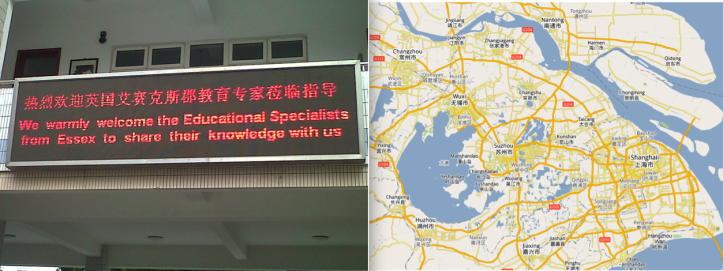
My school is partnered with the remarkable Wuxi No 1 High School and since our link began three years ago we’ve run exchange visits in both directions and received various delegations of teachers from Wuxi and neighbouring Suzhou, two cities inland from Shanghai.
The process is mutually beneficial as we all have a great deal to learn from each other. The rate of development in China is well documented and it is quite breath-taking to see the scale of their vision in building the country’s infrastructure.

Education is a key plank of their overall strategy and the various levels in the Education Bureau hierarchy have huge budgets to invest; part of this is used to fund their international partnership work as internationalising education is one of their goals. The approach to education is similar in many ways and much of the curriculum content is very familiar. However there are key differences, often driven by the need for scale. Chinese schools can be huge with primaries of 2000 and high schools with 5000 students.

Class size is another key difference. A typical class is 40-50 students, always in rows of individual tables where the students are based the entire time.

In our partner school, there is a lot of presenting from the front, but not exclusively by the teacher. Projectors and laptops were almost standard in the classes I’ve seen and teachers talk a lot about ‘p p t’ – powerpoint.

Primary classrooms are even bigger in general and the rows of desks are there from the start. In the picture below, children learn the pin yin system copying an animated cartoon character… lots of IT resources are available for the teachers and we saw sophisticated visualisers used to model hand-writing. Importantly, Chinese Primary teachers are specialist subject teachers too. Maths education in particular is a specialist area from the beginning.

Another major difference is the working pattern for both students and teachers – at least in the schools we have visited. Mainly Chinese teachers only have 2 or, at most, 3 classes a day, with each lasting 45 minutes; typically each day is the same in a week. The rest of the day would be for preparing lessons, marking work from each of the teacher’s students (about 100 bits of work per day) and seeing some students to give individual help. Schools have a lot more teachers per student with each one teaching much less than their UK counterparts but doing daily marking in very high volume.

Students at Wuxi No 1 High School work incredible hours. Essentially they study all day long; they have to devote themselves to it. In the more elite schools this is fuelled by parental expectations and by the intense competition to get into the highest status universities. The curriculum in the High Schools is narrow compared to GCSEs but broader than our A levels with little choice – essentially two paths: sciences or humanities. The state Galkao exams take place on two days in June every year – nicely efficient but very high stakes for the students.

It is interesting that English is a core subject and it remains a part of most university programmes too. China is very much outward looking at this level. The picture shows phrases from a baseball match report. Schools often have specialist laboratories for practical science work..

The arts and sport are a feature of school life but not in a formal taught way in the high schools. However there is still a lot of activity with large -scale drills and basketball and table tennis featuring prominently.

The daily eye exercises are accompanied by some ‘relaxing’ music over the tannoy system with each class doing this in unison. It has a similar status to acupuncture in terms of its efficacy. The cultural exchange aspect of the visits is always so interesting. Chinese schools are full of slogans which, when translated, always sound very poetic and grand.. And there are some amusing by-products of translation.
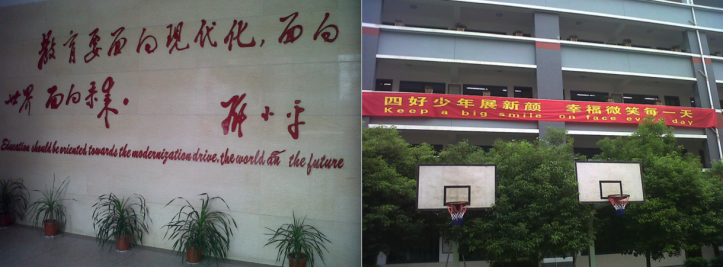
I particularly liked these poetic Keep of the Grass signs:
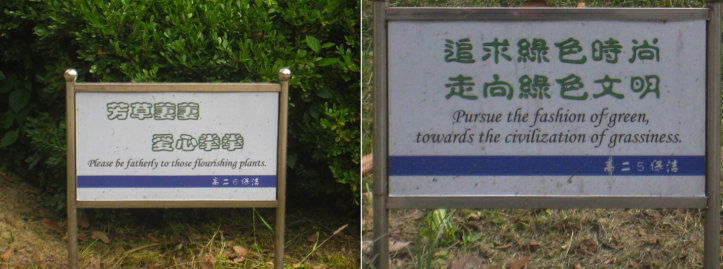
Part of the visit is building a relationship with our counterparts. I established a bond with Principal Hu, my opposite number at the time, and enjoyed some of the more touristy aspects of the trip. For Chinese teachers coming to England, it is almost always their first trip overseas, even after teaching English for 25 years. It means a great deal to them and inevitably sight-seeing is high on their agenda.
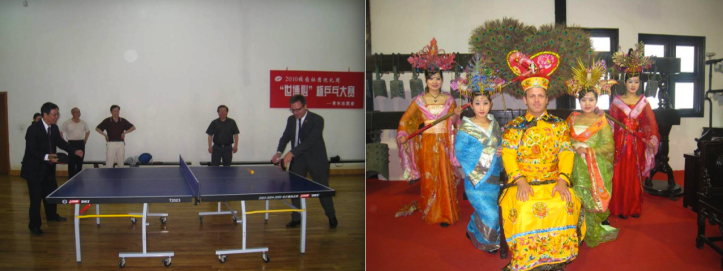
On a 2011 trip, I went in order to brief the school officials in Wuxi about contemporary thinking in UK Education. They were also very interested to hear about OfSTED.
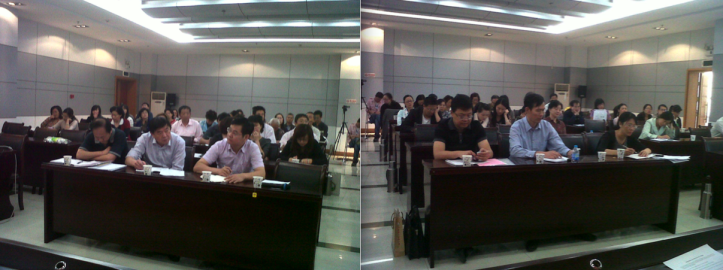
Nationally, the Chinese are conscious that the narrow curriculum and didactic pedagogy is not generating a nation of creative thinkers, even though they excel in Maths, English, Science and Chinese. We had great fun introducing them to the idea of group work and student-centred learning. They were not comfortable with it all but they said they could see the benefits. There was a lot more discussion and laughter than we had in the majority of our sessions.
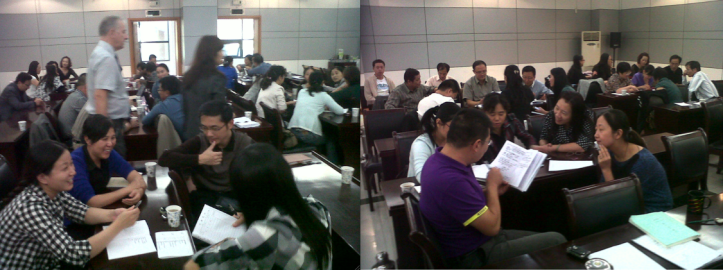
At KEGS, our link with China still feels as if ti is in its infancy and it takes a lot of energy to sustain it. However, the rewards are significant. Our Mandarin GCSE option is very popular and I hope we can keep it that way. China is opening up steadily and by exchanging ideas about teaching and learning we have a lot to learn. At the very least, it is an excellent opportunity to reflect on what we do. Smaller classes – but more lessons in a day…less didactic and less examination focused? Would we swap that for the Chinese method? Probably not…but if we could bottle just a bit of that work ethic ??
I’ll leave the politics for another post…. but that is interesting and more subtle than I’d appreciated.

Two comments for you Tom>
1. Chinese primary schools employ specialists – this is clearly easier given the larger size of their schools but I think it is definitely a key issue for us here in the West to think about – what kind of primary teachers do we want?
2. Coincidentally I mentioned Shanghai in my own post today (on the London Schools Excellence Fund) and will now link back to this post – it was a small comment about publishing London results only for PISA assessments, which is what the Chinese do with Shanghai, even though their tests take place more widely.
LikeLike
[…] There is evidence that London is already doing well on average compared to the rest of England based on certain educational performance measures. Some of these need to be treated with caution, as with all attempts to evaluate learning outcomes and generalise across schools, though perhaps the UK should copy China, which only allows data on its best performing city (Shanghai) to be published in PISA assessments – results from last year’s PISA tests already confirm there is exceptional practice going on as also indicated in this simultaneous post by ‘headguruteacher’, Tom Sherrington. […]
LikeLike
Hi Tom. Enjoyed your reflections on China. You have really focused on the similarities & differences within schools. I was out in Beijing & Chengdu last autumn and I was particularly taken by the cultural, social & political learning available for colleagues. I am finding it hard to envisage my pupils studying mandarin-such a difficult language to learn. Setting up a link involving 3 Lancashire Schools to create exchange opportunities for teachers and pupils. My own blog of my visit is linked below if you are interested.
Twitter @htphil
LikeLike
Hi, I am a dance teacher currently based in Shenzhen, China. I find the main school education here certainly impacts on the way I deliver my lessons (which are extra-curricular), and your point about creativity is an interesting one. I was previously UK based so I would be very interested to follow your collaboration. I’ll keep an eye out for posts!
LikeLike
Specialist teachers in Primary has been at the forefront of my thinking since I started as a teacher – seems to make sense learning wise but same arguments keep coming back – logistics, skill sets and finance. Still something I’d like to further though!
LikeLike
Fascinating! We can lot a lot from the Chinese example. I fear that the 7.30am- 5.30pm day structure may be the detail that Gove would take from this example, ignoring the fact that teachers are afforded more time to mark, plan and help within the working day!
LikeLike
[…] a training session on MFL strategies led by KEGS staff. I had interviewed all 30 teachers in April on my visit to China so it was good to see them in England and fascinating to join the session later in the day when […]
LikeLike
[…] have gone from strength to strength. I wrote a little about my Easter trip to China in this post: A Chinese Education. The photo shows one of our students engaged in a skype session with one of his counterparts at […]
LikeLike
[…] highlights of the year were going to China -( see A Chinese Education), going to the Latitude Festival and then visiting Pompeii on our family holiday. I also […]
LikeLike
[…] I spent the first week of the Easter holiday in China taking part in the pre-departure training for 30 teachers of English due to spend a month in Essex later this summer. It was my third trip to C… […]
LikeLike